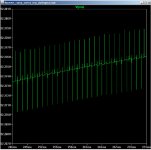Jeff, what didn't you like about the topology of Jam's suggestion back in post #618?
This is (or at least was meant to be) descendant from that. Did I mess something up?
(I did move one of the LTP legs as it seemed to help something, but I can't remember what now.)
... Is this the topology you tried out the darlington and CFP?
Haven't tried them in this one yet. FWIW, the pass device seems to contribute less in this topology so I think they've got a better chance of working out well....
And finally, a topology where the Darlington is superior. 
Note that the 2SD2081 is likely to be actually worse than the TIP122 in this circuit as its hFE falls off more at low collector currents.

Code:
best MOSFET (IRFB4110): 20mOhm output impedance
Darlington (TIP122): 15mOhm
discrete Darlington (KSC1845/D44H11): 10mOhmNote that the 2SD2081 is likely to be actually worse than the TIP122 in this circuit as its hFE falls off more at low collector currents.
No and yes. Missing gate stopper was accidental, but phase lead comp didn't seem to be doing anything.
Speaking of which, do I need the output capacitor? It doesn't seem to contribute anything....
I take the second part back -- a tiny bit (10p) of phase lead capacitance does improve the margins.
...I wonder if attaching the tail of the differential to negative supply might help performance, then again maybe not.
Likes a little bit less phase lead comp this way, but overall performance is worse.
Cheers,
Jeff.
It wouldn't be an astonishing surprise if the #646 circuit performed poorly when the load current is a 1 kHz square wave, that alternates between 5% max-load-current and 95% max-load-current, with 25 nsec rise time and fall time on the edges of the current waveform.
It will stimulate one of the asymmetries in the topology.
It will stimulate one of the asymmetries in the topology.
Jeff,
Hedge cutter.......Hahaha....nice one. (you should be doing stand up comedy).
(you should be doing stand up comedy).
You are getting there, a few more tweaks and you will probably have an eminently suitable supply.
Since the circuit is essentially Class-A (essentially constant current), you won't have deal with "headge-cutter" loads........
The correct circuit (load) for the application at hand is the way to go.
Jam
Hedge cutter.......Hahaha....nice one.
You are getting there, a few more tweaks and you will probably have an eminently suitable supply.
Since the circuit is essentially Class-A (essentially constant current), you won't have deal with "headge-cutter" loads........
The correct circuit (load) for the application at hand is the way to go.
Jam
Attachments
Last edited:
Jeff,
Try a resistor say 250 ohm to 1k from base Q19 to emitter of Q9.
Jam
I assume you mean base Q10 to emitter Q9?
Results are uniformly worse. I also tried a voltage divider wiring the midpoint to the base/emitter junction inside the Darlington, but also to no avail.
How 'bout that output capacitor? Do I need it?
Cheers,
Jeff.
Huge win on the voltage-divider bypass cap. (This is also how I fixed the low frequency in one of the earlier MOSFET shunt regs -- not sure why it didn't occur to me to try it here.)
Using 10uF allows me to either (a) increase bandwidth that it's within spec down to 2Hz, or (b) drop the CRC capacitors to 2,200uF so that I can fit 105º versions.
Preferences?
(FWIW, going up to 100uF still doesn't allow "cake and eat it too".)
Using 10uF allows me to either (a) increase bandwidth that it's within spec down to 2Hz, or (b) drop the CRC capacitors to 2,200uF so that I can fit 105º versions.
Preferences?
(FWIW, going up to 100uF still doesn't allow "cake and eat it too".)
Hmm... can't repeat my earlier results. Best I can get with the 85º CRC caps & the new bypass is 6Hz.
Note that because C2 no longer gives us phase lead comp I had to add dominant-pole comp. Margins are a still healthy 58º & 20dB.
BTW, just to be clear what happens below the frequencies in question, the output impedance at 2Hz is:
30mOhms 85º 3.3mF CRC + bypass
40mOhms 105º 2.2mF CRC + bypass
40mOhms 85º 3.3mF CRC
50mOhms 105º 2.2mF CRC
Note that because C2 no longer gives us phase lead comp I had to add dominant-pole comp. Margins are a still healthy 58º & 20dB.
BTW, just to be clear what happens below the frequencies in question, the output impedance at 2Hz is:
30mOhms 85º 3.3mF CRC + bypass
40mOhms 105º 2.2mF CRC + bypass
40mOhms 85º 3.3mF CRC
50mOhms 105º 2.2mF CRC
Jeff,
I usually use 4700uF for the CRC but 2200uF should work fine. You should be a be able to get 105º that have the same diameter that are slightly taller. I think the key here is more capacitance.
Could you try replacing the first transistor in the darlington with a BC505 (higher beta) if you have the model. This might pay some dividends....maybe.
Jam
I usually use 4700uF for the CRC but 2200uF should work fine. You should be a be able to get 105º that have the same diameter that are slightly taller. I think the key here is more capacitance.
Could you try replacing the first transistor in the darlington with a BC505 (higher beta) if you have the model. This might pay some dividends....maybe.
Jam
This is a case where higher (100V) voltage rating for the CRC caps would be better for long term reliability than 105° vs 85° temp rating. The higher voltage rated parts will tend to have higher ripple current rating as well, which these amps will need.
The bigger caps may always be bypassed with small (470 nF) film caps to improve high frequency performance. Also, be sure to leave enough room inside the chassis for large bulk supply caps on the outputs of your regulators. The output stage will most likely sound better with something in the range of 18 mF to 24 mF setting the dominant low frequency pole of the system. That is regardless of what your simulations tell you. Use your ears instead.
The bigger caps may always be bypassed with small (470 nF) film caps to improve high frequency performance. Also, be sure to leave enough room inside the chassis for large bulk supply caps on the outputs of your regulators. The output stage will most likely sound better with something in the range of 18 mF to 24 mF setting the dominant low frequency pole of the system. That is regardless of what your simulations tell you. Use your ears instead.
Last edited:
I don't have a SPICE model for the BC505, but I played around with some other very-high-gain alternatives. I noticed that I had some gain peaking up in the 10s of MHz that compromised my stability margins -- and it turns out not to be a result of the very-high-gain devices. (I had just failed to notice it before.)
I tried slowing down the Darlington to avoid the problem. This worked, but of course slow transistors are mostly obsolete and hard to find.
Then it dawned on me to use one of those unusually-high-Cob Zetex thingies in the first stage of the Darlington. Worked a charm, and in fact, makes a fine dominant pole too (so I could get rid of the Miller cap).
Specs with ZTX851/MJE340:
70dB attenuation down to 8Hz
10mOhm output impedance 8Hz - 100KHz
5uV residual ripple
phase margin 75º (gain margin infinite)
Looks pretty swell to me....
I tried slowing down the Darlington to avoid the problem. This worked, but of course slow transistors are mostly obsolete and hard to find.
Then it dawned on me to use one of those unusually-high-Cob Zetex thingies in the first stage of the Darlington. Worked a charm, and in fact, makes a fine dominant pole too (so I could get rid of the Miller cap).
Specs with ZTX851/MJE340:
70dB attenuation down to 8Hz
10mOhm output impedance 8Hz - 100KHz
5uV residual ripple
phase margin 75º (gain margin infinite)
Looks pretty swell to me....
Tungsten,
Funny thing you should mention that...granted that higher voltage caps last longer, but I find that lower voltage caps sound better.
Strange thing about 105º caps is that apart from their temperature rating they tend to have a lower ESR generally.....go figure.
I asked a cap manufacturer about this once and he concurred, this according to him is to do with construction techniques and resultant ESR, he also mentioned that electrolytic perform better closer to their rated voltage.
So his conclusion was to use low ESR 105º caps close to (within 20%) their rated voltage. Listening test tend to bear this out but I find that the electrolytic capacitor quality after the regulator can have more impact on the sound than the ones before the regulator (assuming you have enough capacitance in this position).
Jam
Funny thing you should mention that...granted that higher voltage caps last longer, but I find that lower voltage caps sound better.
Strange thing about 105º caps is that apart from their temperature rating they tend to have a lower ESR generally.....go figure.
I asked a cap manufacturer about this once and he concurred, this according to him is to do with construction techniques and resultant ESR, he also mentioned that electrolytic perform better closer to their rated voltage.
So his conclusion was to use low ESR 105º caps close to (within 20%) their rated voltage. Listening test tend to bear this out but I find that the electrolytic capacitor quality after the regulator can have more impact on the sound than the ones before the regulator (assuming you have enough capacitance in this position).
Jam
Last edited:
- Home
- Amplifiers
- Pass Labs
- JamJar: an HPA-1-inspired power amp

